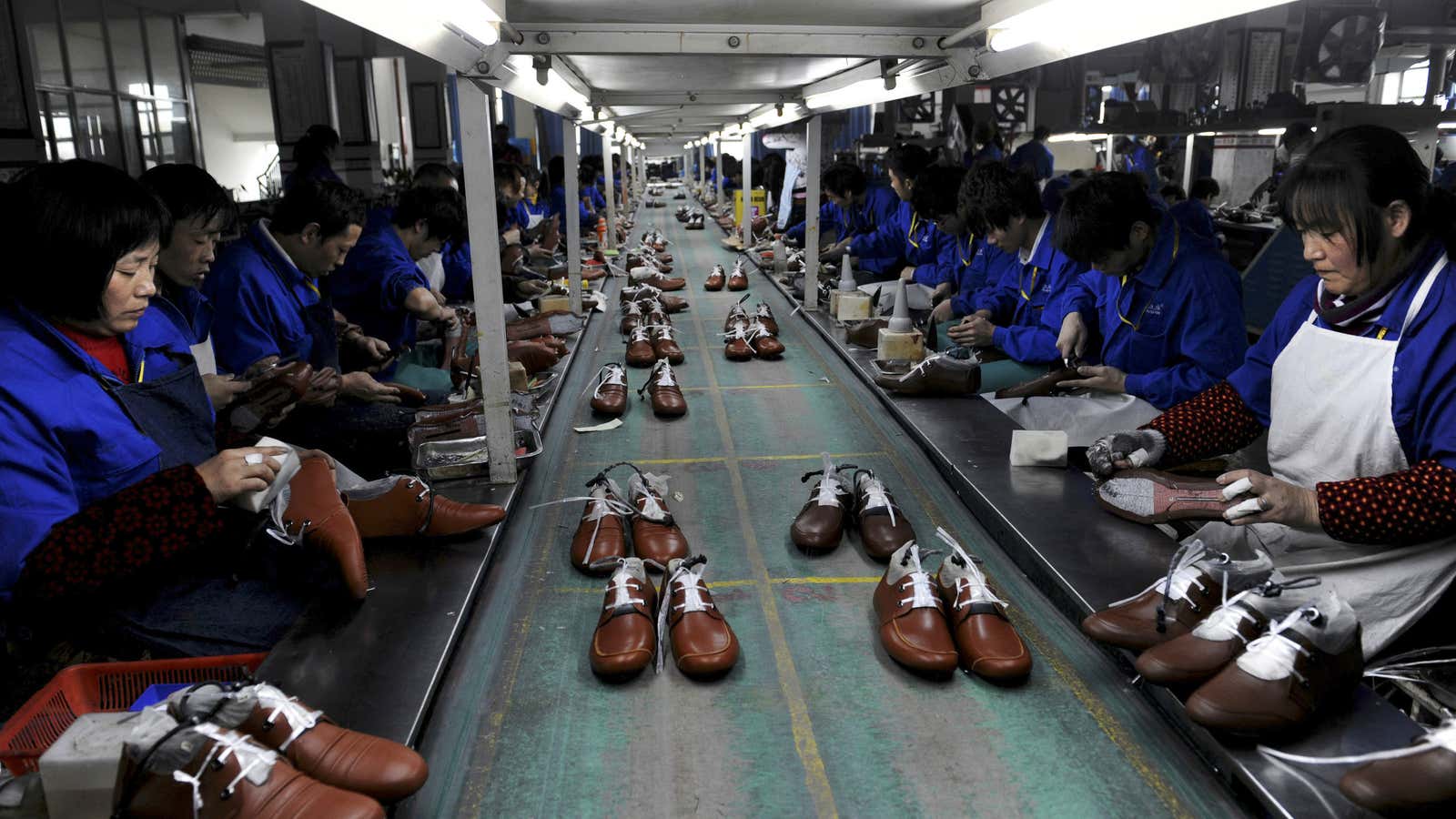Donald Trump’s meeting with Chinese president Xi Jinping starting Thursday (April 6) at Mar-a-Lago will finally give the US president a chance to meet face-to-face with the leader of the country he has trash-talked ceaselessly, describing it numerous times as the source of “trade deficits and job losses.” Peter Navarro, Trump’s trade advisor, published a diatribe against China in which he repeatedly claims ”they took our jobs” and calls on US politicians to restore the country’s manufacturing sector.
Trump’s complaints aren’t necessarily entirely wrong—but in economics, as in most of life, timing is everything. Offshoring, globalization, and free trade have undoubtedly moved some American jobs towards China, as US labor unions warned two decades ago.
But, these days, the version of China that Trump continues to rail against is increasingly out-of-sync with the China that exists today. Its economy, much as other developed economies have already done, has begun transitioning towards a post-industrial economy. The manufacturing boom that powered China’s economic rise over the last two decades has started to draw to a close—and making goods is getting more expensive relative to other economies.
The growth of China’s manufacturing output has slowed over the past half-decade. Production grew 6.9% year-on-year in February this year, compared to over 11% in mid-2013—though those figures may be inflated (government statistics from China can be unreliable).
Meanwhile, the number of people employed in manufacturing has just begun to shrink. According to Nicholas Lardy of the Peterson Institute, citing data from China’s National Bureau of Statistics, the total number of people employed in manufacturing dropped for the first time in more than a decade in 2015, from 79.61 million the previous year to 78.4 million.
Separate data suggests that this shrinking began even earlier. A government index estimating manufacturing employment has remained below 50 since 2012; a figure below 50 indicates declining employment. In March it finally rose to 50.0.
The main reason for manufacturing becoming more expensive is labor costs, which have risen significantly. The country’s shrinking working-age population has made each employee more valuable, and the government has steadily instituted minimum wage raises in order to reduce labor strife. While average worker salaries remain considerably lower than that of the US, numbers from data firm CEIC shows they have nevertheless nearly doubled between 2008 and 2015.
The average person working at a state-owned enterprise in 2008 earned 2,408 yuan per month (about $343, using historic currency conversion rates), which rose to 5,169 yuan per month ($749) in 2015. Workers in private enterprises in their home areas, and migrants working away from their official residence, also saw monthly wages go up from roughly 1,400 yuan per month (about $203) to 3,100 yuan per month ($450). The country’s monthly GDP per capita as of 2015 was $669, according to the World Bank.
As a result, some Chinese manufacturers are moving to other countries, where labor is cheaper and regulation is even more lax, especially now that Beijing has ramped up efforts to curb pollution. Low-margin industries in particular, like apparel, have fled China for places like Vietnam or Myanmar. In 2013, shoe-maker Crocs and leather goods company Coach said they intend to significantly lower the percentage of their products that are made in China by partner manufacturers, with an eye towards relocating to Southeast Asia (paywall).
Overall, China’s economy has shifted noticeably away from manufacturing and towards “services,” which includes everything from hotel front-desk assistants to quantitative analysts. Since 2012, government data suggest that the GDP from services actually exceeds GDP from manufacturing.
To this end, China’s economic structure is beginning to look more and more like that of a developed country—just one that’s much poorer, and warped by the state’s unceasing involvement in the market.
Meanwhile, to keep up output while mitigating labor costs, China has begun investing heavily in automated manufacturing. Beijing aims to boost output of industrial robots to 100,000 units per year by 2020, a rate it’s currently set to exceed. Last year, industrial robots marked the fastest-growing industrial product made domestically (albeit from a small base).
The US, of course, is doing the same. Whatever jobs China took from the US may now also be leaving China, and will probably not come back to either country.
Stealing American jobs has ”not stopped, but at the very least slowed down to a trickle,” says Christopher Balding, who teaches economics at Peking University in Shenzhen.
He points to the asymmetrical investment policies China and the US hold towards one another as a more productive area for Trump to focus on. While the US is barred from investing in countless industries in China, Chinese money flows freely into US real estate, technology companies, film production studios, and universities. But, he said, when it comes to China’s impact on the average American’s economic future, “Trump and Navarro are totally overplaying their hand.”
